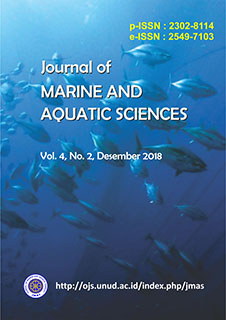Laju Pertumbuhan Rumput Laut Gracilaria sp Melalui Budidaya IMTA (Integrated Multi Trophic Aquaculture) di Pantai Geger, Nusa Dua, Kabupaten Badung, Bali
Abstract
Gracilaria sp is red alga which belong to class rhodophyceae. It can grow in shallow salt water with a general characteristic is having a cylindrical and branched thallus form. Seaweed cultivation can be performed through IMTA (Integrated Multi Trophic Aquaculture) method. The basic principle of cultivation through the IMTA method is utilizing service of the low thropic level species in marine ecosystems, such as shells and seaweed. This method is believed to be able to overcome the environmental problems caused by cultivation activities, such as feces and uneaten feed. This research was perfomed 45 days, from February 25 to April 11, 2017. It was held at Geger Beach, Nusa Dua, Badung Regency, Bali, using a complete randomized design method that consist of three treatments and three repetition for each treatment. Treatment control (T1) consisted of 10 bunches of seaweed 100 grams without the abalone, treatement 2 (T2) consisted of 10 bunches of seaweed 100 grams and 20 abalones and treatement 3 (T3) consisted of 10 bunches of seaweed 100 grams and 40 abalones. The result showed that specific growth rate in Gracilaria sp. was highest in treatment T1, compared to treatment T2 and T3. This was caused by the cage construction of abalone amd the present of small mesh size net to cover the seaweed planting, which made the growth was not optimal. However, the use of a nets system in seaweed cultivation could minimize the loss of thallus. It was proved by the survival rate of seaweed in first, second and third, that is averagely high, ranging from 90% to 100%. Physical and chemical water quality parameters are also measured, and It showed that the water quality was suitable for the cultivation of both, seaweed and abalone.
Downloads

This work is licensed under a Creative Commons Attribution 3.0 International License.
Copyright 2012 - 2023 Journal of Marine and Aquatic Sciences (JMAS)
Published by Fakultas Kelautan dan Perikanan Universitas Udayana, Denpasar, Bali, Indonesia
JMAS (p-ISSN 2302-8114; e-ISSN 2549-7103)


